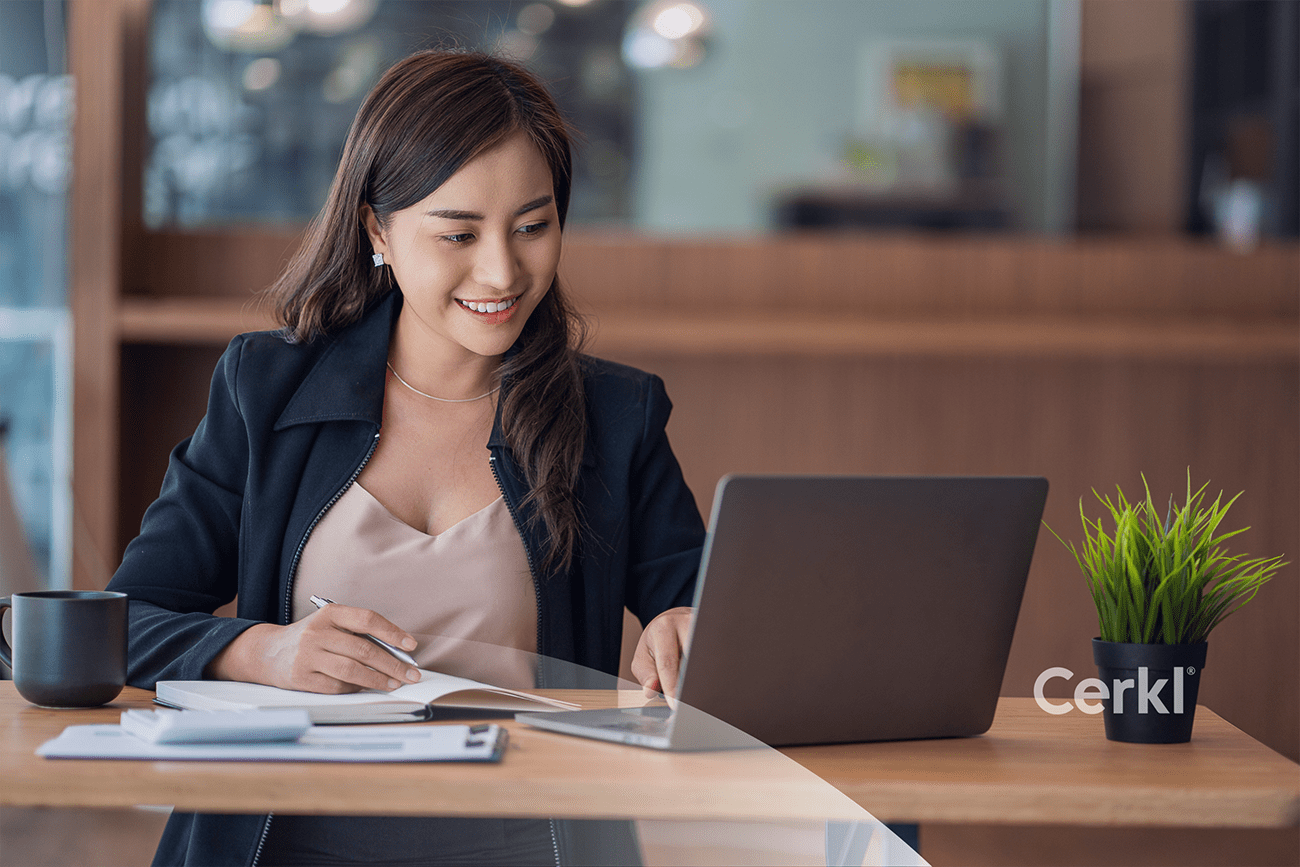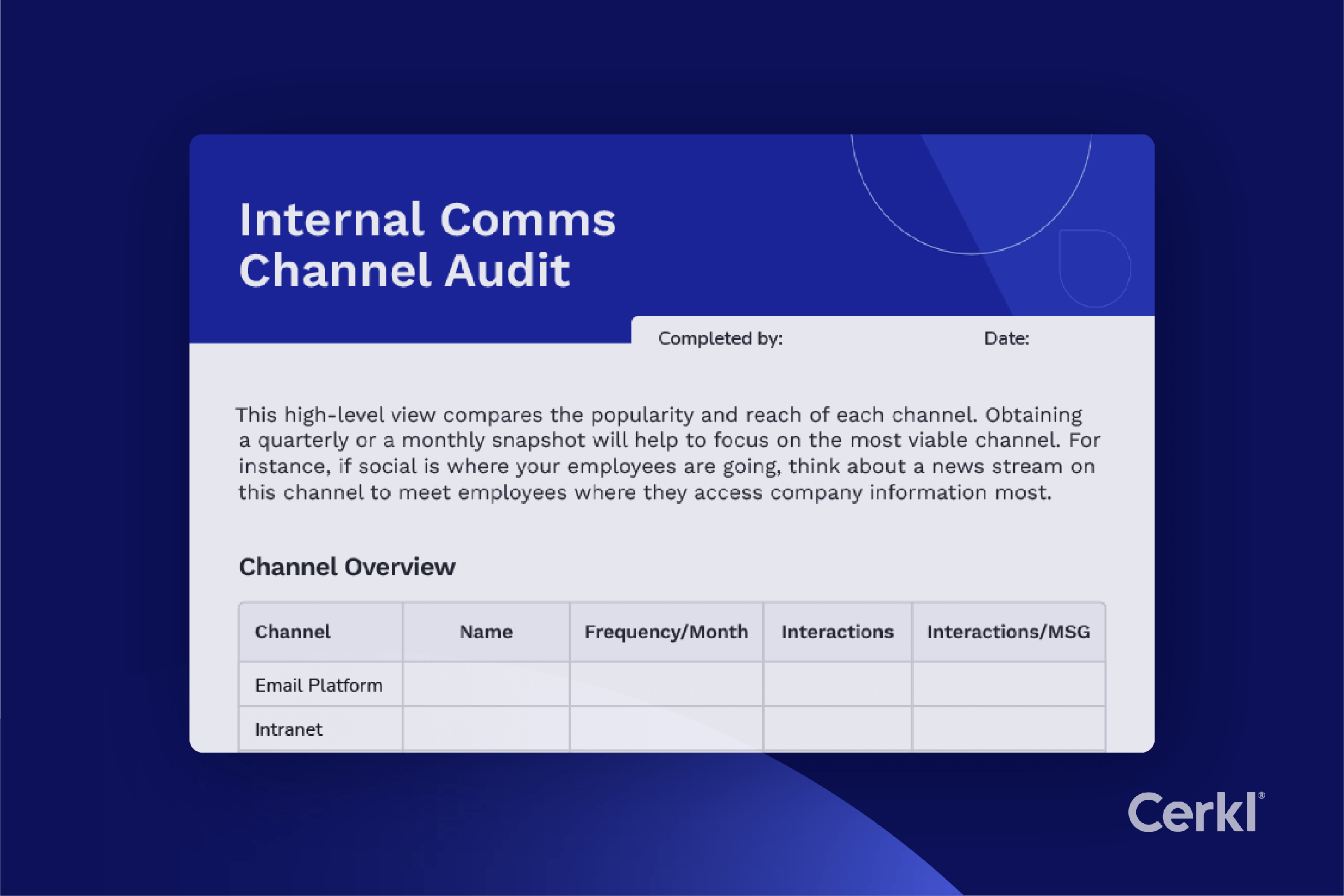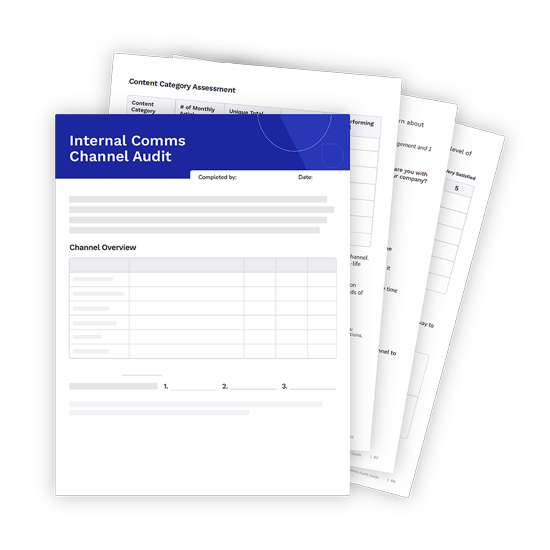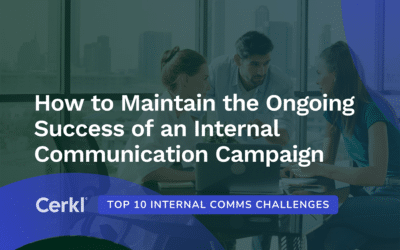Internal communicators have a “tough terrain to navigate.” We know this to be true – and it’s been confirmed by definitive Gallagher research. So, it stands to reason that organizations need to do all they can to ensure those in charge of internal communications have the tools and techniques to succeed. One of these is the all-important internal communications content calendar.
Table of contents
- Discover the Power of an Internal Comms Calendar
- Importance of Internal Communication
- How Do Organizations Communicate Change
- What Is an Internal Communications Calendar?
- What Is the Purpose of a Communications Calendar?
- 7 Steps To Create an Internal Communications Content Calendar
- Implement Your Content Calendar
- How Can Cerkl Broadcast Help You with an Internal Comms Content Calendar?
- What’s Next?
“No one could have predicted that we would experience a third consecutive year of significant change, especially one that further influenced a deep shift in personal and organizational priorities.From war to inflation, global events have affected each of us individually, leaving internal communicators with a tough terrain to navigate.”
Gallagher
Gallagher’s State of the Sector 2022/23 report on Internal Communication and Employee Experience talks about the “deep shift” in both organizational and personal preferences in the past three years. Of course, one of the most radical impacts has been the COVID-19 pandemic and its role in establishing remote work as a new norm.
They follow this statement up with a myriad of statistics that relate to internal communications and all-important employee experience (EX). These include an assessment that 71% of companies lack a long-term internal communication strategy. Without a long-term strategy, organizations may fail on many levels.

A long-term internal communication strategy is crucial for fostering consistent organizational alignment, employee engagement, and cohesive company culture over time.
A content calendar can help immensely by providing a structured plan for disseminating relevant information. This ensures timely and consistent communication and facilitates effective coordination across various internal channels. So, let’s take a look at internal comms calendars and how they can help your overall internal communications strategy.
Discover the Power of an Internal Comms Calendar
There are many tools available for internal communications, some of which are more common and/or effective than others. In this post, we’re going to focus on the internal communications calendar which, as it turns out, is surprisingly underused.
We’re going to start out by taking a quick look at the importance of internal comms. Then we’ll see what Gallagher researchers discovered when they surveyed organizations to find out how they communicate in times of change. We will discuss what an internal communications calendar is and what it is used for. You will discover how you can create, implement, and manage your internal communications content calendar for seamless and engaging communication.
Ultimately, we aim to help you discover the power of a well-crafted internal communications content calendar. Our time-saving tips will help you optimize your workflows and improve internal comms within your organization.
How effective is your internal communications strategy? Do you do regular audits to ensure it remains aligned and impactful? If you don’t, you can easily lose track of how engaged your employees are — or aren’t. Get valuable insights by using Cerkl’s free audit template today.
Download Your Free Strategic Internal Communications Audit Template Now
Our template will enable you to assess how well your internal comms are working and how your employees feel. You’ll be able to assess the core competencies, shortcomings, growth potential, and challenges of your comms, and move forward accordingly.
Importance of Internal Communication
Most of Gallagher’s State of the Sector report represents the opinions of internal communicators (38%) and HR professionals (34%). The rest of those who participated in the survey came from management and leadership positions (11%), PR (7%), or were employee experience experts (2%), in marketing (2%), operations (1%), IT (1%), and various other undefined roles (4%).
Nearly three-quarters of these people (74%) say that the purpose of internal communications is to support company culture and a sense of belonging to the organization. This indicates a shift from communicating company strategy and its vision and purpose. What is particularly interesting is that the overriding themes appear to be:
- Diversity, equity, and inclusion (DEI)
- Values and behaviors
- Emotional and physical wellbeing

This indicates a growing alignment between human resources (HR) and internal communication professionals.
But nearly half (46%) say their organizations don’t invest enough in communication technology. As a result, the disparity between the potential offered by digital innovation and the actual digital experience encountered by employees continues to widen.
The Harris Poll and Grammarly 2023 State of Business Communication report, 2023 The Path to Productivity, Performance, and Profit found that 72% of leaders agree that good communication increases productivity at work. But it also shows that as much as $1.2 trillion is wasted in hidden costs every year because of poor communication. Nearly half (43%) of the business leaders surveyed said a major impact of poor communication is lowered productivity. Alarmingly, only 28% of those surveyed for Grammarly’s previous State of Business Communication felt this to be a major factor.
Additionally, the report states that employees report higher levels of stress because of poor communication in the workplace.
How Do Organizations Communicate Change
The increasing significance of employee well-being, sustainability, and diversity, equity, and inclusion has introduced new challenges. These have been further intensified by the heightened focus on the employee experience following the Great Resignation seen in various industries during (and after) the pandemic. The reasons behind the Great Resignation are complex and include factors such as remote work preferences, reassessment of work-life balance, concerns about health and safety, and a reevaluation of career priorities.
But how well are organizations utilizing communication to manage the impact of these and other changes on employees? Those responding to the Gallagher survey were asked to rank their organization’s ability to implement several tools to communicate change. They were, in the order they ranked the best (excellent as opposed to poor, adequate, or simply good):
- Visual identity
- Long-term vision
- Communication calendar
- Understanding of different audiences
- Leaders acting as role models
- Change narrative
- A network of advocates
- Insights into employees’ understanding and adoption of change
The report notes that the top two stood out with a little more than 50% positive (excellent + good) votes each. But two that scored surprisingly poorly were a communication calendar and a change narrative — both of which are relatively simple to execute.
Another statistic worth noting is that close to 90% of organizations reported an intention to introduce change programs in 2023.
A communication calendar is a great tool for internal communication planning and strategizing, especially in the face of change. Yet 58% of organizations don’t articulate a change narrative or design a calendar of scheduled communication activity.
What Is an Internal Communications Calendar?
So, what is a calendar of communication? In essence, it’s a very basic internal communication planning tool organizations can use to schedule and organize internal communications activities over specific periods. It serves as a roadmap for the timing and content of internal messages, ensuring that communication efforts are consistent, strategic, and aligned with organizational goals.
An internal communications content calendar typically includes details such as:
- Dates and timeframes that specify when certain internal comms will be disseminated, whether it’s via a weekly newsletter, monthly updates, or special announcements.
- Content and topics that provide an outline of themes, subjects, or key messages to be communicated during various time periods.
- Identification of the communication channels that will be utilized, whether it’s email, intranet, team meetings, or other internal platforms.
- A definition of the target audience for each communication. This is vital to ensure messages are tailored to the needs and interests of specific groups within the organization.
- Inclusion of significant events, milestones, or deadlines that might impact internal communications planning.
Having a well-organized internal comms calendar helps teams stay proactive, ensures that important messages are not overlooked, and contributes to a more cohesive and effective internal communications strategy.
What Is the Purpose of a Communications Calendar?
An internal communications calendar serves several important purposes within any organization. It is a valuable tool for organizations to plan, organize, and optimize their internal and external communication efforts, contributing to a more effective and cohesive internal communications strategy.

It helps in the strategic planning of communication initiatives by outlining when and how messages will be delivered to various audiences. This ensures that communication efforts are aligned with broader organizational goals and priorities.
An internal comms calendar promotes consistency in messaging. By scheduling timely, regular communications, it helps maintain a steady flow of information, preventing gaps or periods of silence that might lead to confusion among employees. It also helps in the efficient allocation of resources, including time and manpower. Teams can plan and prepare content in advance, reducing last-minute rushes and ensuring that messages are well-crafted and effective.
An internal communications content calendar facilitates coordination among different departments or teams within an organization. It helps prevent conflicting messages and allows for the synchronization of communication efforts across various, pre-determined channels.
This type of calendar allows organizations to align communication efforts with important events, milestones, or key dates. It ensures that relevant messages are delivered at the right time and in the context of broader happenings.
By specifying the target audience for each communication, your internal comms calendar ensures that messages are tailored to the needs and interests of different groups within the organization.
It also provides a framework for evaluating the effectiveness of communication initiatives. Teams can assess the impact of messages based on scheduled milestones and adjust their strategy accordingly.
Just remember, while providing a structured plan, an internal communications calendar should also allow for flexibility. It should accommodate changes in priorities, unexpected events, or emerging opportunities that may require adjustments to the planned communication schedule.
7 Steps To Create an Internal Communications Content Calendar
If you haven’t discovered the power of an internal comms calendar yet, now’s the time to break out and give it a try. Here are seven simple steps to follow to create one.
#1 Define Your Objectives
Clearly outline and articulate the goals and objectives of your internal communications efforts. What do you want to achieve with your content calendar? This could include improving employee engagement, promoting key initiatives, or enhancing information flow.
#2 Identify Your Target Audience
Identify the different audiences within your organization. You’re going to have to tailor your content to address the specific needs and interests of each group.
Be aware that different teams or departments may have varying communication needs.
#3 Identify Key Messages and Themes
It’s important to plan your internal communications content calendar carefully. At an early stage, determine the key messages and themes you want to convey during the specified time period. Align your messages with organizational goals, initiatives, or current priorities. Also list events, annual surveys and reporting, holidays, industry observances, award submissions, conferences, and so on that you know about. These are things that won’t, or unlikely to, change.
You’re going to want to include different departments in your internal comms calendar. This means collaboration from an early stage. For instance, HR may have an employee health initiative. Ask for tentative dates and include these on the calendar. Then set up a quick meeting with your department’s point person a week before their campaign launches to ensure that things run smoothly.
You also need to add all of the reoccurring events and materials that your internal comms department is responsible for. This includes your newsletters, town halls, any collateral, or even a quarterly video update from the CEO.
#4 Selection Suitable Communication Channels
It’s important to identify the distribution channels you are going to use to distribute the content included in your internal comms calendar.
Gallagher found that 25% of organizations lack the appropriate channels to message employees. One aspect that struck researchers was that only 33% reported having “a channel-specific editorial calendar.” The suggestion is that internal communicators and others responsible for sharing messages and announcements create content on an ad hoc basis. This indicates that little effort is invested in production.
#5 Assign Roles and Responsibilities for Content Creation
Clearly define roles and responsibilities for content creation, review, and distribution. Assign tasks to individuals or teams who will be responsible for generating specific pieces of content.
Establish a workflow for content creation and approval.
#6 Identify Milestones and Events to Include
Integrate significant milestones, events, or deadlines into your internal comms content calendar. Align communications with these dates to provide context and relevance.
Be aware of any external events that might impact internal communications planning.
#7 Populate Your Internal Comms Calendar Regularly
Populate the content calendar with planned topics, dates, and responsible parties. Ensure that the calendar reflects a balanced distribution of content types and addresses the varying needs of your audience.
Be sure to include significant milestones, events, or deadlines that may impact your content schedule. This is one area where a content calendar can be vitally important.

Implement Your Content Calendar
Implementing an internal communications content calendar involves putting the plan into action and ensuring that the scheduled content is created, distributed, and monitored according to the established timeline. It is also important to establish a review and approval process for the content. Define who will be responsible for reviewing and approving each piece of content. Allow sufficient time for review to ensure accuracy and alignment with organizational goals.
Make sure that you share your internal communications content calendar internally to be transparent and show the amount of valuable work that you do. Show your superiors that you’re a strategic communicator with a well-thought-out plan, not just someone who takes orders!
Of course, the calendar is just the beginning. You’re also going to have to make a plan to get the content that is detailed on the calendar. And you’ll need to decide on one or more formats you are going to use for delivery.
For example, there are a few formatting styles that you should keep in mind when building email templates.
Using an internal communications platform with pre-made templates is a great daily time-saver. If you’re not a fan of what’s readily available, make sure that they have an easy-to-use editor. You shouldn’t have to waste a whole workday putting together one email. You have too much going on already.
If neither of these work for your team, it looks like you’ll be going with the classic HTML approach. Assuming that a team member can build an HTML template, make sure that you plan a quarterly check-in to update and create more templates for different use cases.
How Can Cerkl Broadcast Help You with an Internal Comms Content Calendar?
Cerkl Broadcast can simplify your efforts with cross-channel communications. The platform offers an omnichannel that you can use to distribute internal comms to your intranet, email newsletter, and employee communication app without your employees seeing the same thing multiple times.
Using your different RSS feeds, Broadcast grabs all of the content you’re already creating and streamlines the distribution process. There’s no need for you or your team to double their efforts.
What’s Next?
If you need more input in terms of the effectiveness of your existing internal communications plan, complete our strategic internal communications audit. It’s quick, easy, and free.
FAQ
An internal comms calendar is a planning tool that schedules and organizes the timing and content of internal messages within an organization.
The purpose of a communications calendar is to provide a structured framework for planning and organizing communication efforts. It ensures consistency, alignment with organizational goals, and effective engagement with target audiences.
To create an internal communication calendar, define objectives, identify target audiences, select communication channels, establish a template structure, gather input from stakeholders, and assign responsibilities. Then populate the calendar with content, establish a review process, communicate the calendar to relevant parties, and regularly review and reuse it based on feedback and organizational changes.
A content calendar should include dates, topics, key messages, responsible parties, communication channels, and significant milestones or events. It should also include a structured plan for regular review and adaptation based on performance metrics and feedback.






